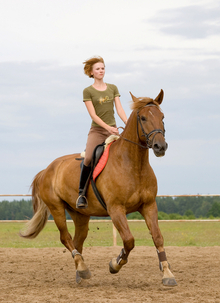
"Nervous and fidgety" tells us that your horse is afraid of something in the mounting situation. We know he is motivated to escape because he moves before you are ready. In these situations, pain and punishment are feared most often.
Underlying this are a number of initiating factors, such as loss of balance during mounting, or pain from a tight saddle. Of course how your horse came to be fearful relates to his individual life experience.
Something I will ask you to do is review your horse's history as you know it in order to identify any reasons for fear: Do you know what happened the first time this behaviour occurred?
Generally speaking, there are some common potentially aversive components to mounting that lead to bad experiences for horses: Mounting from anywhere but a tall block (or bank or fence) involves the rider pulling themselves up onto the horse, rather than lowering gently onto their back.
Consider this
Every time you interact with your horse be it feeding, catching, walking, riding, you are training him and if you keep this in mind and use your understanding of horse behavior, not only will you be safer, but your horse will learn quicker.
All our body weight on one stirrup, even momentarily, pulls the saddle tree into the side of the spine behind the shoulder. This can be painful, especially if the horse already has some pain in this area. Fear of this alone causes a number of horses to avoid going to the mounting block or standing quietly for their rider to get on board.
Mounting can also be unbalancing, especially in a green horse. I like to make sure my horse has his weight evenly distributed over all four feet before I get on, leaning even a little on the forehand before a rider is in the saddle will have the horse moving forward to regroup himself once the rider is on board.
To address this, I may even rock a green horse a little to make sure they are balanced and ready, and I do make sure this is part of the earlier training process to help the young horse organize himself in advance, so he is not accidentally frightened by loss of balance.
In some cases, the first ever experience of a rider can have a lot to answer for. Oftentimes people expect naive horses to be fearful, and to run and buck as a consequence. This fear is taken as inevitable, so preparatory work to reduce it is not undertaken.
There are two common approaches in these cases: Either to have one or two handlers hold the horse tight so that the frightened horse doesn't move (and often becomes more fearful because he feels trapped). Or use a round pen technique, driving the horse forward with a skilled rider who simply rides through the bucks (usually staying on).
In either case the horse may not get over the first fright, so never becomes really solid for mounting, because nagging doubts about their situation leads to tension, and motivation to escape or avoid the whole thing.
Once the horse is motivated to escape and avoid mounting they perform behaviour their rider does not want, and often in sheer frustration the rider delivers some reprimand; a jab on the reins, a harsh word, or even a gentle, soothing tone that nevertheless comes with increased rein tension intended to hold the horse still.
Did you know?
For a prey animal such as a horse, having any other animal, such as a human, get on his back can cause powerful and dangerous reactions in an untrained horse because of his instinctive fear.
This increased rein tension is more salient to the fearful horse than their loving human's well meant words, so even this gentler approach is unpleasant and fear inducing.
Since all of these things are aversive to horses, they often add to their anxiety about being mounted up, so in some cases they increase the horse's motivation to escape, rather than teach the horse to stand still.
In addition to lack of motivation to cooperate, ultimately the horse's escape and avoidance attempts actually get reinforced, because they relieve the horse of the situation. This encourages the horse to keep them up or even escalate them!
Moving off when under the rider tends to coincide with the pain of the temporarily lopsided saddle lessening, and with punitive rider behaviour stopping. This much desired relief makes the horse feel as though he has reasonably escaped the worst of the situation, and functions to reinforce him for moving off.
This is what behavioural scientists call 'negative reinforcement', where an aversive sensation ends as a consequence of a specific escape behaviour - which is then repeated by the horse in future, similar occasions.
Incidentally, this is why some punishments work. If the horse finds a consistent way to stop the punishments, by doing the behaviour the rider wanted and avoiding future punishment, the horse will continue to do that behaviour instead of that which is punished.
Additionally, the rider will also have negative reinforcement for using punishment - the relief of having a cooperative horse - also making them more likely to use punishment in the future.
When the horse remains relaxed at each stage (set them up to succeed with baby steps), add a reward such as a good long wither rub and or a food titbit that will take some chewing (hay stretcher pellets or short chopped, unsweetened forage) for the CC phase.
So to recap at this point. Your horse is most likely apprehensive of some impending pain or punishment at the point of mounting. He feels threatened and fidgets as a response. Once you are on board he moves off quickly to get relief from the situation.
Fixing this problem involves reversing the emotions motivating your horse to escape. It will help if you can do some further root cause analysis if at all possible. We have ascertained that he fidgets and moves off too soon because he is afraid and these acts help him cope.
But why exactly does he feel afraid, what initiated the problem? Can you think of anything in his history? The more you delve, the more structure you can actually add to your retraining, helping your horse get over this problem e.g. he moves off because you recall he was spooked by a price of trash blowing out one time early on in his ridden career, so you add in desensitization to plastic as part of your retraining.
To help your horse learn new things about being mounted, that it can be enjoyed, and that it is worthwhile to stand still, your horse has to discover new and interesting things with each aspect of the mounting process.
For example that standing still is rewarded by things the horse likes. As he is unlikely to believe you initially, breaking down mounting into small steps, ones he can tolerate keeping still and relatively calm for, will help you convince him.
The following is an example break down:
- Standing by the stirrup
- Stepping up onto a mounting block or fence
- Placing my hand on the withers
- Gathering the reins
- Taking hold of the stirrup
- Half lifting my foot to the stirrup
- Placing my foot in the stirrup
- Swinging onto my horse
Each of these steps tells the horse, based on their experience, that pain and or punishment is coming. I allow them to discover that each step is now more likely to bring about a reward, by making sure I don't hurt them (don't forget to include your veterinarian or physiotherapist, plus a saddle check and a mounting block that is tall enough in your root cause analysis!) and that they are rewarded every time until they believe they will be rewarded for cooperation.
Even then, rewards of one form or another continue to be given to help keep the faith in a fragile horse. Although once my horse has learned each step separately, the reward comes when I'm in the saddle and ready to go.

Understanding your horse
Once my horse has learned each step separately, the reward comes when I'm in the saddle and ready to go.
This process is known to behaviour professionals as 'systematic desensitization' and 'counter conditioning', or SDS and CC for short. SDS happens first, a relaxed horse is exposed to scaled down, bite sized pieces of the mounting procedure.
When the horse remains relaxed at each stage (set them up to succeed with baby steps), add a reward such as a good long wither rub and or a food titbit that will take some chewing (hay stretcher pellets or short chopped, unsweetened forage) for the CC phase.
The aim of this process is to enable relaxation (SDS) so the horse can form a new, rewarding association (CC) with being mounted. Good luck with your horse!
Remember this
Just because you don't intend to teach a horse something doesn't mean that you won't and just because you are not aware of having taught a horse something doesn't mean you didn't - Equine researcher - J. Hausberger.
